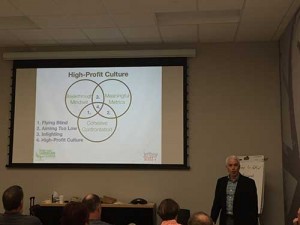
Jeffrey Scott, in partnership with LM, brought his Grow Your Landscape Business Workshop to the Holt Cat facility in Little Elm, Texas, Feb. 25.
Twenty-three landscape company owners and high-level employees were in attendance. Many attendees owned companies in Texas, like Managing Partners Julie Donie and Alexa Villalobos of Fertile Grounds in Austin, Texas. Others traveled farther, such as Owner Mike Pruitt of Master’s Landscape Design in Nashville, Tenn.
“You can’t do what you don’t know,” Pruitt said. “That’s why it’s worth it for me to travel from Tennessee. Obviously there’s the coaching from Jeffrey Scott, but also getting to interact with other leaders in the industry and getting to bounce ideas off one another gives me the ability to do what I didn’t know yesterday.”
The workshop centered on “Jeffrey Scott’s Proven 5 Step-Business Building Process.” The process is based on the following principles: find & motivate better people, surround them with better systems, sell to fill increased production, real time metrics to manage by and keeping yourself time efficient to ensure traction.
Finding and motivating better people
The first half of the day centered on finding good employees, something many companies struggle with. Scott told the group to remember the acronym ABS: Always Be Recruiting.
Even when a company isn’t in looking for a certain employee, or actively recruiting, it should be passively recruiting, Scott said. One passive recruiting tool is an open house, where an entire staff can meet a slew potential applicants in a relaxed environment. Another valuable technique is speaking to sophomores and juniors at local universities through various programs.
“By senior year, it’s too late,” Scott said. “Pick a couple universities and own it. Meet the teachers, give talks and be the one they recommend.”
But passive recruiting can be as simple as a company adding positive video testimonials from employees to its website. These simple things can make a company more attractive to a prospective employee and share a company’s values.
“Put the fun out there,” Scott said. “Maybe it’s a picture of the guys having fun or drinking a beer, if that’s appropriate—something that makes you want to work there.”
The hiring process
Another highlight from the workshop was Scott’s seven-step hiring process. It included the following:
- Write an advertisement—include responsibilities, results expected from job description, benefits and desired behaviors and values. Websites like Indeed and LinkedIn are a good place to start;
- Email correspondence—send a few questions that require thoughtful answers. The email correspondence is a great time to screen undesirable applicants, in an effort to avoid wasting time;
- First phone interview—see if the potential hire can keep an appointment and get a sense of his or her phone skills and professionalism;
- First in-person interview—sell the company, discuss values and inform him or her on the rest of the interview process;
- Second in-person interview—get a feel for the applicant’s values by presenting a case study and determining how he or she would handle the situation;
- Meal with candidate and significant other—or talk to him or her on the phone. How a person handles themselves over a meal and with their significant other tells a lot about their values, Scott said.; and
- Make the offer—stay in touch and discuss on-boarding plan after the hire to build excitement.
It may seem exhaustive, but Scott said the drawn out process prevents fluke interviews, as a prospective hire tends to let his or her guard down as they near the end of the process. Also, a case study can be instrumental in determining a person’s values.
“Don’t say, ‘We’re big on ethics, so tell me a time you were ethical,’” Scott said. “Give them a case study with a question without a right answer. See how they answer and that will tell you their values.”
Employee incentives
Some incentives are simple but can go a long way. One example Scott shared was a Hero of the Week program. It’s more frequent than an employee of the month program and takes more tracking, but frequent reminders can help employees focus on the positives and feel recognized, Scott said.
“Every week someone gets positive recognition for something he should be doing,” he said. “Studies show if you only talk about the negative you’re sending a message that that’s the norm.”
Attendees also heard about the benefits of numerous incentive programs, including insight on profit sharing. Attendees could even hear from the experiences of Donie and Villalobos, of Fertile Grounds, which runs a profit sharing system.
“When employees are incentivized, they become more invested in the success of the company and less out for themselves,” Scott said.
Scott will host two Grow Your Landscape Business Workshops—one in St. Louis and one in Boston—in March.

